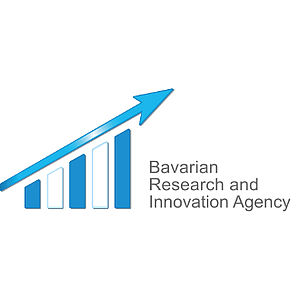
TADFlife
![[Translate to Englisch:] Logo TADFlife](/fileadmin/user_upload/BayFOR-tadflife-logo.png)
The EU project TADFlife: Long-lasting and efficient - researching the third generation of OLEDs
Organic light-emitting diodes (OLEDs) are the future of innovative displays and of the smartphones, monitors and televisions, that use them. OLEDs offer various advantages over non-organic light-emitting diodes (LEDs), enabling displays that are not only lighter and thinner, but even flexible. They also offer a brighter glow, a truly deep black and shorter reaction times than standard LEDs. They also consume less power. Even more energy-efficient displays are now possible with innovative, highly efficient OLEDs that last just as long.
Three kinds of sub-pixels per pixel are required in order to produce the full colour spectrum: red, green, and blue. In particular OLEDs that are responsible for producing blue light still lag significantly behind standard LEDs when it comes to efficiency and performance. The new EU research network TADFlife is currently researching the new generation of OLEDs, with the aim of developing a method that will improve their efficiency and lifespan simultaneously. Among other objectives, the network's scientists are developing new synthesis routes and materials for blue diodes. Moreover, the TADF (thermally activated delayed fluorescence) process is expected to improve the efficiency and light yield of blue diodes further still, thereby boosting future display quality. The EU is funding the project as a Marie Skłodowska-Curie Innovative Training Network (ITN). The interdisciplinary and international approach employed by this ITN is giving 15 doctoral students from all over the world the opportunity to carry out organic LED research. The young researchers are also taking part in a structured training programme that also counts BayFOR among its partners. The programme focuses on interdisciplinary workshops devoted to specific aspects of research and the targeted development of soft skills, including entrepreneurship, project management, science communication, and many others. The programme also gives the doctoral students the opportunity to play an active role in industrial enterprises. A further 19 research institutes and companies from Germany, India, Italy, Japan, Lithuania, the Netherlands, Switzerland, Ukraine, the USA, and the UK are taking part in TADFlife under the coordination of the University of Bayreuth.
Project Overview
Project aims and fields of work
The key objectives of TADFlife are:
- To improve the efficiency and performance of OLEDs
- To extend the service life of OLEDs
- To establish an international scientific exchange between research and industry
- To train and provide networking opportunities for first-rate scientists for Europe's benefit
- To produce highly-qualified experts for a broad field of work
- To boost Europe's image as a place of science
The technical objective is to significantly maximize both TADF-OLED efficiency and the service life of OLEDs simultaneously. Tackling a multifaceted and complex problem of this nature, which is of decisive importance for the development of the OLED industry, requires a cross-sectoral, multidisciplinary approach that extends beyond the capabilities of a single institution.
An additional objective of the project is to bring together leading European academic and industrial expertise in the areas of synthesis, quantum chemistry, spectroscopy, photophysics, device physics, simulation, and technology in order to elucidate the simple yet profound question of how efficient and long-lasting TADF-OLEDs can be produced - especially in the case of deep blue emission. TADFlife will develop models that will help identify the causes of insufficient lifespans and overcome them.
At the same time, the project will train a new generation of versatile researchers from the fields of chemistry, physics, and material sciences for the new and expanding OLED sector.
These new experts will receive a unique training experience that will comprise both academic and industrial experience in Europe and valuable secondments at leading East Asian and American research institutions. The participants will be able to apply their newly-acquired skills in other fields, such as functional materials as well as electronic and photonic technologies.
Target groups
The TADFlife project results are relevant for the following stakeholders:
- Science
- The electronics industry
- The chemical industry
- Consumers
BayFOR as a partner
The Bavarian Research Alliance provided intensive support to TADFlife, from writing the project application to project start in October 2018. Its supporting role in the conception and submission of the application was performed in close cooperation with the project coordinator. It also provided assistance with the necessary formalities to all partners (Participant Portal).
"I'm very pleased to have the opportunity to contribute to the success story of organic LEDs together with this international team, which became a possibility thanks to the support of BayFOR during the application phase."
Prof. Anna Köhler, the University of Bayreuth
As a partner organization, BayFOR will work together with the TADFlife network to provide support to young researchers as part of the TADFlife training programme with workshops in the areas of application phase and project management designed to develop their skills for their future careers. BayFOR will also present the project at international trade fairs and events.
Funding
The TADFlife project receives a funding of EUR 3.9 million from the European Union’s Horizon 2020 research and innovation programme as a Marie Skłodowska-Curie Innovative Training Network (ITN) (Horizon 2020, Call: H2020-SEC-2016-2017-2) aunder grant agreement No. 812872 from October 2018 until September 2022. EUR 1.3 million of this funding will be received by Bavarian stakeholders.
Consortium
The TADFlife consortium consists of 19 research institutes and companies from Germany, India, Italy, Japan, Lithuania, the Netherlands, Switzerland, Ukraine, the USA and the UK.
Coordinator
University of Bayreuth (Germany)
Project partner
University of St Andrews (UK)
University of Parma (Italy)
Universität Augsburg (Germany)
Institute of Physics of the National Academy of Sciences of Ukraine (Ukraine)
Durham University (UK)
Vilnius University (Lithuania)
Merck KGaA (Germany)
Simbeyond BV (Netherlands)
Fluxim AG (Switzerland)
Bavarian Reasearch Alliance (Germany)
Light Conversion (Lithuania)
Schrödinger (USA)
Kyushu University (Japan)
Seoul National University (Korea)
University of Southern California at Los Angeles (USA)
Georgia Institute of Technology (USA)
Iowa State University (USA)
Indian Institute of Science (India)
TU Eindhoven (Netherlands)
Kyoto University (Japan)
Further Information
Official project website: www.itn-tadflife.de
Contact

Prof. Dr Anna Köhler
Faculty of Mathematics, Physics und Computer Sciences
Chair of Experimental Physics II
University of Bayreuth
95440 Bayreuth
Phone: +49 (0) 921 55 260 0
Email: anna.koehler@no-spam-pleaseuni-bayreuth.de
Contact at BayFOR

MBA Gabriela Blumberger
Scientific Officer Information & Communication Technologies | Engineering & Natural Sciences and Project Manager
Phone: +49 89 9901888-132
Email: blumberger@no-spam-pleasebayfor.org




